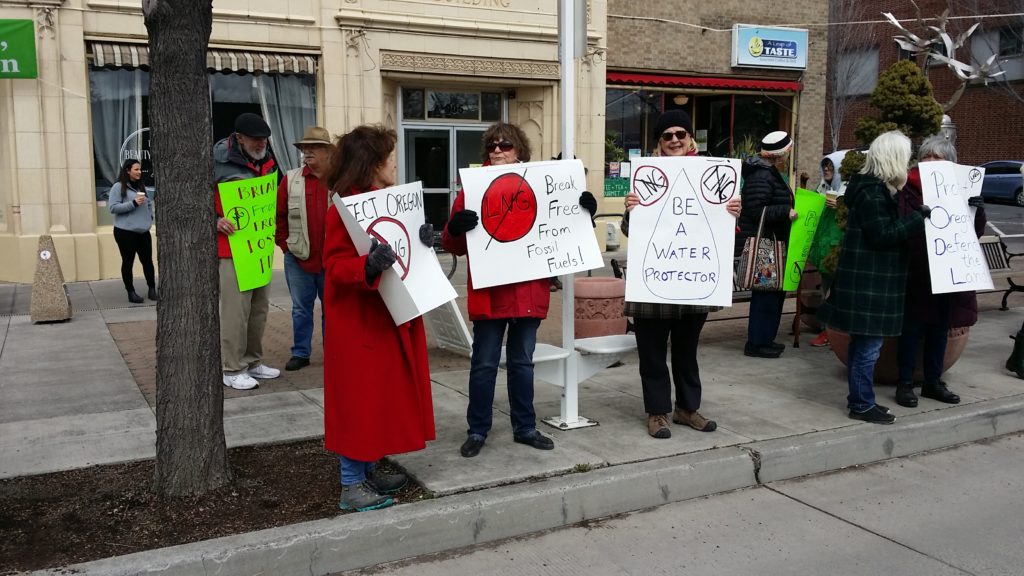

On Thursday March 28, 2019, several members of LWV Klamath County joined with others to demonstrate against the proposed LNG pipeline. This was part of our continuing efforts to engage in activities relevant to our community. Attending were Valerie Lenardson, Diane Eastman -Shockey, Christina Pasillas, Julie Ryder, Leslie Lowe, and former LWV member Barbara Turk.
For further information: Indivisible Klamath
According to a recent Klamath Indivisible press release:
- The proposed Pacific Connector gas pipeline would be built across public and private lands. After 13 years, 60 landowners object to this pipeline and could have their land seized by eminent domain;
- The pipeline would cross 485 rivers, streams and wetlands including the Rogue, Klamath and Umpqua rivers, and impact the fishing and tourist industries;
- Constructing the pipeline would require clear-cutting a 95-foot buffer through public lands, impacting a region with significant fire and earthquake hazards;
- The pipeline would carry 1.6 billion cubic feet of fracked gas per year;
- Despite Pembina’s claims in its thousands of TV ads and mailers, LNG pipelines are not safe. Gas pipelines and facilities are highly explosive, and have resulted in injuries, deaths and evacuations;
- The pipeline would end at a huge refinery called Jordan Cove, built at Coos Bay, on our pristine and protected Oregon coast;
- The project threatens cultural resources, traditional tribal territories and burial grounds of the Karuk, Yurok and Klamath Tribes. They oppose the project;
- The project would not result in additional jobs. An estimated 1,000 temporary workers would be involved with the construction, most from out of state;
- Promoting more Liquified Natural Gas is a huge step backward for fighting climate change. Fracking wells produce substantial amounts of methane which could be worse than coal in a 20-year timeframe. The U.S. Department of Energy says shipping natural gas from the U.S. to Asia could end up being worse than if China simply built a new power plant and burned its own coal supplies. And the terminal would become the largest source of climate pollution in the state;
- The project benefits two foreign interests: Pembina, a Canadian fossil fuels company, and the Asian markets that will receive the LNG shipped from Jordan Cove.
Here is information from Pembina, Inc. Pipeline proposal
Pembina continues to progress its proposed liquefied natural gas export terminal in Coos Bay, Oregon, and the related Pacific Connector Gas Pipeline that will transport natural gas from the Malin Hub in southern Oregon to the export terminal. In September 2017, the Company filed applications with the United States Federal Energy Regulatory Commission (FERC) for the construction and operation of Jordan Cove. The Company received a FERC Notice of Schedule during Q3 2018 and based on that notice, currently anticipates a final FERC decision on Jordan Cove in November of 2019. Pembina continues to anticipate first gas in 2024, pending the receipt of the necessary regulatory approvals, a positive final investment decision and other requirements.
Project highlights:
- 7.8 MMTPA (~1.3 Bcf/d) greenfield liquefied natural gas export facility
- Price competitive with USGC brownfield on a delivered into Tokyo basis
- 9 days shipping to Tokyo with no hurricane risk or Panama Canal risk
- Access to long-term and diverse natural gas supply from WCSB and US Rockies
- Large-scale existing regional gas transportation network
- ~229 mile (~369 km) greenfield pipeline to connect Malin Hub in southern Oregon to Jordan Cove Terminal